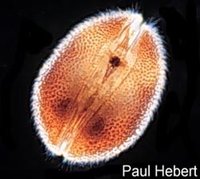
(Source: Biodiversity Institute of Ontario)
| Ostracoda | ||
| Arthropoda | Ostracoda |
| Arthropoda | Eucrustacea
└─► |
|||
| Maxillopoda | None |
Malacostraca |
|
Abbreviated Dendrogram
Crustacea
├─Phosphatocopida
└─┬─Branchiopoda
├?─Xenocarida
╘═╤═Maxillopoda
├─Ostracoda
└─Malacostraca
|
Contents
|
Taxa on This Page
This content on this page copied verbatum from Encyclopedia of Earth - Crustacea under Creative Commons Attribution Share-Alike license. It is intended at some point to add additional material on evolution, paleontology, etc MAK120517
 (Source: Biodiversity Institute of Ontario) |
Ostracods are small crustaceans enclosed in a bivalved carapace. They are the oldest known crustaceans in the fossil record because their shells preserve well. They occur in nearly every aquatic habitat from polar lakes to tropical oceans, and they are important microfossils for dating ancient sediments.
 (Source: Biodiversity Institute of Ontario) |
Ostracods are small animals, ranging in size from 0.3 to 30.0 mm, although most freshwater species range between 0.5 and 2.5 mm. Their bodies are completely enclosed in a calcified, bivalved carapace which is hinged dorsally. The surface of the shell may be smooth or pitted, punctuated, wrinkled, or reticulated. Several large muscles are directly attached to the carapace, and these points of attachment leave scars that are useful in discriminating some groups of ostracods.
Adult ostracods have 6 to 7 pairs of appendages. Although distinct segmentation is absent, the head possesses four pairs of appendages including the antennules, antennae, mandibles and maxillae, while the thorax has 3 pairs of legs.
 (Source: Biodiversity Institute of Ontario) |
Freshwater ostracods go through eight moult stages before they mature. Their life span varies from one month in temporary ponds to a year or longer in larger water basins. Reproduction may be either sexual or asexual. Some lineages are exclusively parthenogenetic , but other species reproduce sexually.
Freshwater ostracods are remarkable for their high frequency of species which have abandoned sexual reproduction. While transitions to parthenogenesis are rare in most other animal groups, about one-third of all freshwater ostracods have given up sex. The breeding system employed by any population is easily determined, as asexual populations contain only females, while sexual populations include both males and females.
Very few ostracod species incubate their eggs within their body; most lay their eggs either singly or in groups on sediment or aquatic vegetation. These eggs may hatch soon after they are laid or remain undeveloped for a year or longer. The ability of eggs, larvae, and adults to withstand freezing and desiccation is a very important biological characteristic which aids the dispersal of ostracods from one body of water to another.
 (Source: Biodiversity Institute of Ontario) |
Freshwater ostracods are free-living except for members of one group which are commensal on the gills of crayfish. Most free-living forms are benthic, though pelagic forms also occur.
Ostracods possess the largest sperm in the animal kingdom in both relative and absolute terms. Ostracod sperm can be up to ten times the length of the male's body! Some male ostracodes need a special organ (Zenker's organ) to aid in sperm transport.
From "Crustacea", Encyclopedia of Earth. Eds. Cutler J. Cleveland (Washington, D.C.: Environmental Information Coalition, National Council for Science and the Environment) 100219; revised 110529; Creative Commons Attribution Share-Alike